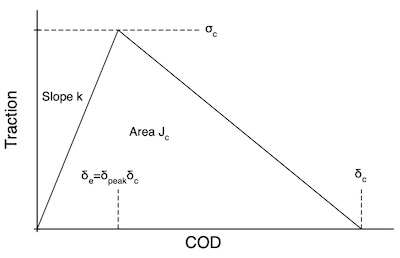Triangular Traction Law
Traction Law
This traction law in pure mode I or pure mode II each have the triangular shape shown in the figure. There are separate traction laws for opening displacement (mode I) and sliding displacement (mode II).
The toughness of this traction law is the area under the curve or:
[math]\displaystyle{ J_c = {1\over 2} \sigma\delta_c }[/math]
When creating this traction law, you have to enter exactly two of these failure properties for both mode I and mode II (i.e., two of JIc, σI, and δIc and two of JIIc, σII, and δIIc). Whichever property is not specified will be calculated from the other properties using the following relations:
[math]\displaystyle{ \delta_c = {J_c\over 500\sigma}, \qquad \sigma = {J_c\over 500\delta_c}, \qquad {\rm or} \qquad J_c = 500\sigma\delta_c }[/math]
These relations assume JIc in J/m2, σ in MPa, and δc in mm.
To get the initial rise and location of the peak, you can provide, k, and the relative crack opening displacement at the peak stress, δpeak (it is relative to the critical opening displacement and therefore from 0 to 1). You must enter zero or one of these terms above for both mode I and mode II (i.e., zero or one of kIe and δI,peak and zero or one of kIIe and δII,peak). If one is provided, the other will be calculated from:
[math]\displaystyle{ k = {\sigma\over \delta_{peak}\delta_c} }[/math]
If neither k nor δpeak are entered, the peak will be located at δpeak = 0.225926299. This location provides the closest match to the [[Cubic Traction Law|cubic traction law] for area under the curve as a function of cod. The initial slope will be set to
[math]\displaystyle{ k = {\sigma\over 0.225926299 \delta_c} }[/math]
To get pure linear softening, you can enter zero for δpeak of either mode. Although a pure linear softening law is allowed, experience suggest that having an initial elastic region before the peak with finite slope k works better. Thus if you experience problems with a pure linear softening law, the solution might be to increase the peak positions to make the initial stiffness finite.
Mixed-Mode Failure
The entered traction laws give mode I or mode II traction law for pure mode I or pure mode II loading. For mixed-mode loading, the normal and and shear tractions still depend only on normal and shear displacements, respectively, but the conditions for failure change. Under pure mode loading, failure occurs when the relevant displacement reaches the critical displacement. For mixed-mode loading, failure occurs when:
[math]\displaystyle{ \left({G_I\over J_{Ic}}\right)^{n} + \left({G_{II}\over J_{IIc}}\right)^{n} = 1 }[/math]
where GI and GII are areas under mode I and mode II traction laws up to current displacements and n is mixed-mode criterion parameter. This failure criterion will mean that failure may occur when normal or shear tractions are nonzero and result in a sudden drop to zero traction. This approach is identical to the one adopted by Thouless et. al to handle mixed-mode loading and appears to work well. There has been work to modify the traction laws so they always approach zero at time of failure (e.g., work of Hogberg (2006) or Tvergaard and Hutchinson (1994)). These approaches were tried, gave poor results for certain problems, led to non-physical coupling between mode I and mode II, and therefore were abandoned.
